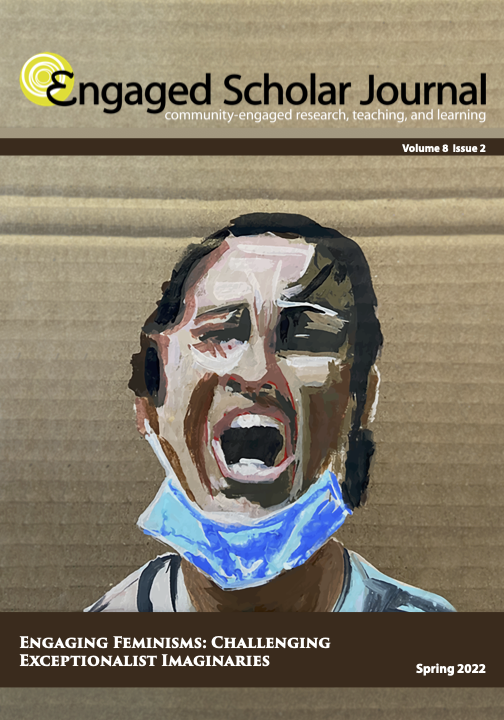Collaborative Movement: What Queering Dance Makes Possible
DOI:
https://doi.org/10.15402/esj.v8i2.70778Keywords:
Queer and trans dance, feminist community research, queer methodsAbstract
Collaborative Movement focuses on an ongoing research collaboration centred on supporting trans/genderqueer/non-binary/queer community dance/movement programming and mentorship in Regina, Treaty 4 territory. Incorporating queer feminist community research methods, this article demonstrates that collaborations between community organizations and academia can be productive in their grounding of ideas (about gender and bodies) in everyday complexities and specificities of place in ways that hold potential for new forms of interaction, new ways of relating to each other, and new possibilities for action.
References
Ahmed, S. (2006). Queer phenomenology. Routledge.
Brim, M., & Ghaziani, A., (2016). Introduction: Queer methods. Women’s Studies Quarterly, 44(¾), 14-27. https://doi.org/10.1353/wsq.2016.0033
Brackenbridge, C. H., Rivers, I., Gough, B., & Llewellyn, K. (2007). Driving down participation: Homophobic bullying as a deterrent to doing sport. In C. Aitchison (Ed.), Sport and gender identities: Masculinities, femininities and sexualities (pp. 122-139). Routledge.
Cameron, L., & Oliver, D. (2021). “We’re number fat!”: Reflections on Fat Fastpitch with The Heavy Hitters. Fat Studies, 10(3), 283-296. https://doi.org/10.1080/21604851.2021.1907111
Cantrick, M., Anderson, T., Leighton, L. B., & Warning, M. (2018). Embodying activism: Reconciling injustice through dance/movement therapy. American Journal of Dance Therapy, 40, 191-201. https://doi.org/10.1007/s10465-018-9288-2
Carter, C. (2021). Who’s coming out to play? Disruption and disorientation in Queer community sports.
McGill-Queen’s Press.
Carter, J. (2017). Chasing feathers: Jérôme Bel, Swan Lake, and the alternative futures of re-enacted dance. In C. Croft (Ed.), Queer dance: Meanings and makings (pp. 109-124). Oxford University Press.
Chaleff, R. (2018). Activating whiteness: Racializing the ordinary in the US American postmodern dance. Dance Research Journal, 50(3), 71-84. https://doi.org/10.1017/S0149767718000372
Caudwell, J. (2020). Transgender and non-binary swimming in the UK: Indoor public pool spaces and un/safety. Frontiers in Sociology, 5(64). https://doi.org/10.3389/fsoc.2020.00064.
Creese, G., & W. Frisby (2011). Feminist community research: Case studies and methodologies. UBC Press.
Croft, C. (Ed.). (2017). Queer dance: Meanings and makings. Oxford University Press.
DeFrantz, T. F. (2017). Queer dance in three acts. In C. Croft (Ed.), Queer dance: Meanings and makings (pp. 169-180). Oxford University Press.
Desmond, J. (Ed.) (2001). Dancing desires: Choreographing sexualities on and off the stage. University of Wisconsin Press.
Edward, M., & Greenough, C. (2020). Queer literacy. In R. Iphofen (Ed.) Handbook of Research Ethics and Scientific Integrity (pp. 707-718). Springer, Cham. https://doi.org/10.1007/978-3-319-76040-7
Ellison, J., McPhail, D., & Mitchinson, W. (2016). Obesity in Canada: Critical perspectives. University of Toronto Press.
Green, E. (2021, February 14). Challenging dance aesthetics and representations of bodies through contemporary choreography. Round Lemon. https://www.roundlemon.co.uk/zest-archive/challenging-dance-aesthetics-and-representations-of-bodies-through-contemporary-choreography
Johnson, P. E. (2005). “Quare studies”, or (almost) everything I know about queer studies I learned from my grandmother. In E. P. Johnson & M. G. Henderson (Eds.), Black Queer Studies (pp. 124-157). Duke University Press.
Kirby, S., Greaves, L., & Reid. C. (2006). Experience research social change: Methods beyond the mainstream. Broadview Press.
Lavallée, L., Lévesque, L. (2012). Two-Eyed seeing: Physical activity, sport, and recreation promotion in Indigenous communities. In, J. Forsyth & A. R. Giles (Eds.), Aboriginal Peoples and sport in Canada: Historical foundations and contemporary issues (pp. 206-228). UBC Press.
Love, H. (2016). Queer messes. Women’s Studies Quarterly, 44(¾), 345-9. https://doi.org/10.1353/wsq.2016.0068
McDonald, M. (2009). Dialogues on Whiteness, leisure and (anti)racism. Journal of Leisure Research, 41(1), 5-21. https://doi.org/10.1080/00222216.2009.11950156
Moss, P. (2002). Feminist geography in practice: Research and methods. Wiley-Blackwell.
Muñoz, J. E. (2001). Gesture, ephemera, and Queer feeling: Approaching Kevin Aviance. In J. C.
Desmond (Ed.), Dancing Desires: Choreographing Sexualities On and Off The Stage (pp. 423-444). The University of Wisconsin Press.
Reid, A., Tom, A., & Frisby, W. (2006). Finding the ‘action’ in feminist participatory action research. Action Research. 4(3), 315-332. https://doi.org/10.1177/1476750306066804
Reinharz, S. (1992). Feminist methods in social science research. Oxford University Press.
Riley S., Burns, M., Frith, H., Wiggins, P., & Markula, P. (2008). Critical bodies: Representations, identities and practices of weight and body management. Palgrave Macmillan.
Ruddy, E. (2018, December 18). It’s not that hard to be trans inclusive. Briarpatch. https://briarpatchmagazine.com/articles/view/its-not-that-hard-to-be-trans-inclusive
Sykes, H. (2021). Globalization or coloniality? Delinking from the roving colonialism of sport mega events. In J. Maguire et al. (Eds.), The Palgrave Handbook of Globalization and Sport (pp.133-155). Springer Nature Limited.
Sykes, H. (2016). The gender and sexual politics of sport mega-events: Roving colonialism. Taylor and Francis.
Sykes, H. (2011). Queer bodies: Sexualities, gender, and fatness in physical education. Peter Lang Publications.
Sykes, H., & McPhail, D. (2011). Fatness: Unbearable lessons. In H. Sykes (Ed.), Queer bodies:
Sexualities, gender, and fatness in physical education. (pp. 49-74) Peter Lang Publications.
Valentine, G. (2002). Queer bodies and the production of space. In D. Richardson & S. Seidman (Eds.), Handbook of lesbian and gay studies (pp. 145-160). Sage Publications.
Valentine, G. (1993). (Hetero) sexing space: Lesbian perceptions and experiences of everyday space. Environment and Planning D: Society and Space, 11(4), 395-413. https://doi.org/10.1068/d110395
Van Katwyk, T., & Seko, Y. (2017). Learning through improvisational dance: A collaborative autoethnography. Forum Qualitative Social Research, 18(2). https://doi.org/10.17169/fqs-18.2.2724
Published
How to Cite
Issue
Section
License
Authors who publish with this journal agree to the following terms:
- Authors retain copyright and grant the journal right of first publication with the work simultaneously licensed under a Creative Commons Attribution License CC BY 4.0 that allows others to share the work with an acknowledgement of the work's authorship and initial publication in this journal.
- Authors are able to enter separate, additional contractual agreements for the non-exclusive distribution of the journal's published version of the work (e.g., post it to an institutional repository or publish it in a book), with an acknowledgement of its initial publication in this journal.
- Authors are permitted to post their work online (e.g., in an institutional repository or on their website) after the publication of their work in the Engaged Scholar Journal.
- Please note that while every opportunity will be taken to ensure author participation in the editing process, due to time constraints final copyediting changes may be made before publication to ensure APA adherence throughout all submissions.




